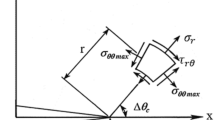Abstract
Mixed-mode crack propagation in anchor bolt pull-out tests of concrete is analysed, based on the maximum circumferential tensile stress criterion of linear elastic fracture mechanics. Analysis is carried out by implementing a two-domain boundary element method for the plane stress condition. Automatic remeshing of the boundary is accommodated with the increment of crack growth, and the prediction of crack trajectory is accomplished by generating new boundaries. In a parametric study, results are presented for five such cases as combinations of two embedded depths of the anchor bolt, different distances from the edge of the anchor bolt head to the reaction supports, and two lateral support conditions. A simplified formula for the estimation of pull-out capacity is derived from the analytical results, as a function of given geometric and material parameters.
Resume
On analyse la propagation de fissures lors d'essais d'arrachement de boulons d'ancrage en s'appuyant sur le critère de contrainte en traction périphérique circulaire maximale de la mécanique de la rupture linéaire élastique. On effectue l'analyse en mettant en oeuvre la méthode spécifique aux éléments finis pour le cas de contraintes planes. Un remaillage automatique des limites s'ajuste avec l'incrément de croissance de la fissure, et la prédiction du trajet de fissuration s'effectue en générant de nouvelles limites. Dans une étude paramétrique, on présente les résultats pour cinq cas tels que combinaisons de deux profondeurs d'encastrement du boulon d'ancrage jusqu'aux supports de réaction, distances différentes depuis le côté de la tête du boulon d'ancrage jusqu'aux supports de réaction et deux cas de supports latéraux. On en déduit une formule simplifiée pour l'évaluation de la capacité d'arrachement à partir des résultats analytiques en fonction de paramètres géométriques et relatifs aux matériaux donnés.
Similar content being viewed by others
References
Ballarini, R. and Shah, S. P., ‘Fracture mechanics based analysis of pull-out tests and anchor bolts’, in ‘Analysis of Concrete Structures by Fracture Mechanics’ edited by L. Elfgren and S. P. Shah (Chapman & Hall, London, 1991) pp. 245–280.
Elfgren, L., ‘Round robin analysis and tests of anchor bolts’, in ‘Fracture Mechanics of Concrete Structures’, edited by Z. Bažant (Elsevier Applied Science, London, 1992) pp. 865–869.
Schlangen, E., ‘Experimental and numerical analysis of fracture processes in concrete’, Ph. D. Dissertation, Delft University of Technology, The Netherlands, 1993, pp. 93–99.
Eligehausen, R. and Sawade, G., ‘Analysis of anchorage behavior. A fracture mechanics based description of the pull-out behavior of headed studs embedded in concrete’, in ‘Fracture Mechanics of Concrete Structures, From Theory to Applications’, edited by L. Elfgren (Chapman & Hall, London, 1989) pp. 263–280.
Červenka, V., Pukl, R. and Eligehausen, R., ‘Fracture analysis of concrete plane stress pull-out tests’, in ‘Fracture Processes in Concrete, Rock and Ceramics’, Vol. 2 (Chapman & Hall, London, 1991) pp. 899–908.
Chahrour, A. H. and Ohtsu, M., ‘Multi-domain BEM implementation for mixed-mode cracking in concrete’, in ‘Fracture and Damage of Concrete and Rock: FDCR-2’, edited by Rossmanith (E & FN Spon, London, 1992) pp. 196–205.
Chahrour, A. H., Fukuchi, S., Ohtsu, M. and Tomoda, Y., ‘BEM analysis of mixed-mode crack propagation in center-notched concrete beams’,Proc. Jap. Concr. Inst. 15 (1993) 1291–1296.
Cruse, T. A. and Polch, E. Z., Proceedings of the 3rd Japan Symposium on Boundary Element Methods (JASCOME) pp. 111–133.
Smith, R. N. L. and Mason, J. C., ‘A boundary element method for curved crack problems in two dimensions’, in ‘Boundary Element Methods in Engineering’, edited by Brebbia (Springer-Verlag, Berlin, 1982) pp. 472–484.
Ožbolt, J. and Eligehausen, R., ‘Numerical analysis of headed studs embedded in large plain concrete blocks’, Institut für Werkstoffe im Bauwesen, Universität Stuttgart, Report No. 4/10-90/9, October 1990.
Ohtsu, M., Shigeishi, M. and Iwase, H., ‘AE observation in the pull-out process of shallow hook anchors’, in Proceedings of JSCE No. 408/V-11 (Concrete Engineering and Pavements), August 1989, pp. 177–186.
Author information
Authors and Affiliations
Rights and permissions
About this article
Cite this article
Chahrour, A.H., Ohtsu, M. Analysis of anchor bolt pull-out tests by a two-domain boundary element method. Materials and Structures 28, 201–209 (1995). https://doi.org/10.1007/BF02473250
Issue Date:
DOI: https://doi.org/10.1007/BF02473250




